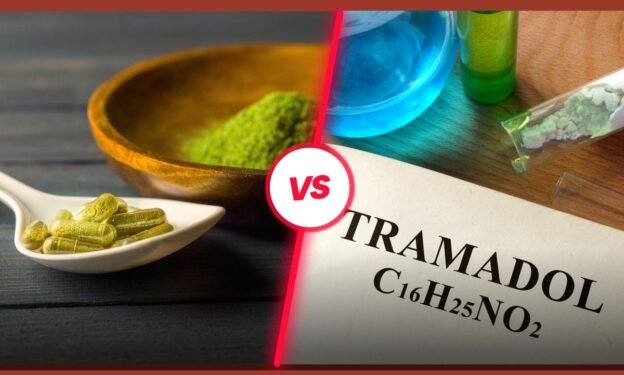Why Compare Kratom and Tramadol?
Kratom and Tramadol are frequently compared because of their pain-relieving effects and opioid-like properties. While both substances interact with opioid receptors in the brain, their origins, mechanisms, and effects on the body are fundamentally different. Tramadol is a synthetic opioid analgesic prescribed for pain, while Kratom is an herbal supplement with active alkaloids that mimic opioid activity.
Despite their differences, both substances can lead to dependence, withdrawal symptoms, and long-term health effects, raising concerns about safety, legality, and medical effectiveness. Understanding the biological mechanisms behind these substances is crucial for anyone seeking pain management solutions or detox options.
What Is Kratom?
Botanical Origin and Active Compounds
For over 26 years, people from all over the world have chosen Waismann Method as their opioid detox provider.
We know the challenges you face and the importance of creating a unique and personal experience for you right from the start.Call for Detox Options 1-800-423-2482
Kratom is derived from the Mitragyna speciosa tree, native to Southeast Asia. The leaves of this tree contain mitragynine and 7-hydroxymitragynine, two alkaloids that act on mu-opioid receptors in the brain, the same receptors that opioids like Tramadol, morphine, and heroin affect. However, Kratom also interacts with adrenergic, serotonergic, and dopamine receptors, creating a unique spectrum of effects.
Physiological Effects of Kratom
Kratom’s effects vary depending on the dosage:
- Low doses (1-5 grams): Acts as a stimulant, increasing alertness, sociability, and energy through adrenergic and dopamine receptor activation.
- Moderate doses (5-10 grams): Provides pain relief and relaxation, engaging opioid receptors and reducing the perception of pain while mildly sedating the nervous system.
- High doses (10+ grams): Acts as a strong sedative, similar to opioids, producing euphoria, drowsiness, and potential respiratory depression.
Uses of Kratom
- Pain relief
- Anxiety and depression relief
- Energy booster (in small doses)
- Opioid withdrawal assistance (unapproved by the FDA)
Side Effects and Risks of Kratom
Kratom, despite being a plant-based substance, has several risks, including:
- Nausea and vomiting
- Constipation
- Dizziness and sedation
- Increased heart rate
- Liver toxicity with prolonged use
- Dependence and withdrawal symptoms (similar to opioid withdrawal)
The long-term use of Kratom can alter brain chemistry and lead to tolerance, making withdrawal painful and challenging.
What Is Tramadol?
Chemical Structure and Mechanism of Action
Tramadol is a synthetic opioid analgesic that works through two primary mechanisms:
- Opioid receptor activation: Tramadol binds to mu-opioid receptors in the brain, reducing pain perception.
- Serotonin and norepinephrine reuptake inhibition (SNRI): Tramadol increases the levels of serotonin and norepinephrine, which help modulate pain signals and influence mood.
This dual mechanism makes Tramadol unique compared to traditional opioids, as it affects both opioid pathways and neurotransmitter balance.
Physiological Effects of Tramadol
- Pain relief through opioid receptor activation
- Mood elevation due to increased serotonin levels
- Reduced neuropathic pain through its SNRI mechanism
Uses of Tramadol
- Post-surgical pain relief
- Chronic pain conditions
- Neuropathic pain management
Side Effects and Risks of Tramadol
Despite being considered a “weaker” opioid, Tramadol has significant risks:
- Drowsiness and dizziness
- Nausea and vomiting
- Constipation
- Seizures (especially in high doses or when combined with other drugs)
- Serotonin syndrome (when combined with antidepressants or other serotonergic drugs)
- Dependence and withdrawal symptoms
Unlike Kratom, Tramadol withdrawal includes additional complications due to its SNRI activity, making detox more difficult and potentially leading to prolonged mood disturbances.
Key Differences Between Kratom and Tramadol
| Feature | Kratom | Tramadol |
| Classification | Herbal supplement | Prescription opioid |
| Active Compounds | Mitragynine, 7-hydroxymitragynine | Synthetic opioid + SNRI |
| Mechanism of Action | Binds to opioid receptors, affects dopamine & adrenergic receptors | Binds to opioid receptors, affects serotonin & norepinephrine |
| Medical Use | Not FDA-approved | Prescribed for pain |
| Addiction Potential | High with long-term use | High, especially at high doses |
| Withdrawal Symptoms | Opioid-like withdrawal | Opioid-like + SNRI withdrawal effects |
| Legal Status | Banned in some states, unregulated | Controlled prescription medication |
| Overdose Risk | Lower but possible | High, can cause respiratory depression & seizures |
Dependence and Withdrawal: Kratom vs. Tramadol
Both substances lead to dependence and withdrawal, though their symptoms differ:
- Kratom withdrawal: Muscle pain, nausea, irritability, insomnia, depression, and cravings.
- Tramadol withdrawal: Anxiety, depression, sweating, nausea, body pain, and potential seizures.
Tramadol withdrawal is more dangerous due to its serotonin and norepinephrine involvement, increasing the risk of psychological disturbances.
Why Medical Detox Is Necessary for Kratom or Tramadol Withdrawal
Abruptly stopping either Kratom or Tramadol can lead to severe withdrawal symptoms, including:
- Restlessness and agitation
- Flu-like symptoms (muscle pain, sweating, nausea)
- Insomnia and mood swings
- Severe cravings
Waismann Method: The Leading Medical Detox for Kratom and Tramadol Dependence
At Waismann Method, we provide:
- Medically supervised detox in an accredited hospital
- Sedation-assisted detox to ease withdrawal symptoms
- Customized treatment plans based on patient needs
- Post-detox care at Domus Retreat for stabilization
Unlike traditional rehab, Waismann Method eliminates opioid dependence efficiently and safely, minimizing suffering and maximizing recovery success.
Conclusion: Understanding the Risks & Choosing the Right Detox Solution
While Kratom and Tramadol both provide pain relief, their risks far outweigh the benefits when used long-term. The addiction potential, withdrawal symptoms, and long-term neurological effects highlight the importance of safe detox solutions.
Frequently Asked Questions:
Is Kratom stronger than Tramadol for pain relief?
Kratom and Tramadol both interact with opioid receptors, but Tramadol is a prescription opioid with a more predictable pain-relieving effect. Kratom’s potency varies based on the strain and dose.
Can you take Kratom and Tramadol together?
Combining Kratom and Tramadol is dangerous because both affect opioid receptors and serotonin levels, increasing the risk of respiratory depression, seizures, and serotonin syndrome.
Which is more addictive, Kratom or Tramadol?
Both substances can lead to dependence, but Tramadol carries a higher risk of severe withdrawal symptoms due to its opioid and SNRI properties. Kratom users can also experience opioid-like withdrawal with prolonged use.
What are the withdrawal symptoms of Kratom vs. Tramadol?
- Kratom withdrawal: Muscle aches, nausea, irritability, sweating, and insomnia.
- Tramadol withdrawal: Anxiety, depression, nausea, flu-like symptoms, and potential seizures due to its SNRI effects.
How does Kratom work differently from Tramadol?
Kratom contains alkaloids that partially activate opioid receptors, while Tramadol is a synthetic opioid that fully binds to these receptors and also affects serotonin and norepinephrine levels.
Is Kratom legal while Tramadol requires a prescription?
Tramadol is a controlled prescription medication, while Kratom is banned in some states but remains unregulated federally in the U.S.
Can you overdose on Kratom or Tramadol?
Tramadol has a higher overdose risk, leading to respiratory depression, seizures, and serotonin toxicity. Kratom overdose is rare but possible, especially in high doses or when mixed with other substances.
How long do Kratom and Tramadol stay in your system?
- Kratom: Detectable in urine for 5-7 days and in blood for 24 hours.
- Tramadol: Detectable in urine for 1-4 days and in blood for up to 48 hours.
What is the safest way to detox from Kratom or Tramadol?
Medical detox in a hospital is the safest option. Waismann Method provides sedation-assisted detox, helping patients detox with minimal withdrawal symptoms.
What is the best treatment for Kratom or Tramadol addiction?
The best treatment is medically supervised detox, followed by professional aftercare. Waismann Method offers one of the safest and most effective opioid detox programs, ensuring a fast and comfortable recovery.
- Mayo Clinic: Kratom for opioid withdrawal: Does it work?
- Mayo Clinic: Kratom: Unsafe and ineffective
- New England Journal of Medicine: Deaths in Colorado Attributed to Kratom
- FDA: FDA and Kratom
- DEA: Kratom, a drug of concern.
- National Library of Medicine: Tramadol Dependence in a Patient With No Previous Substance History. Why is Tramadol Addictive?






